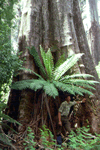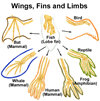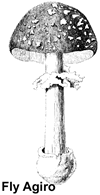|
Animal, plant or fungi? -
A simplified classification system
In the range of living things commonly encountered by the general community,
most living things (organisms) can be classified into three broad groups:
plants, animals and fungi, based on the way they obtain food.
Most biologists actually classify all living things into five groups
(known as "kingdoms") with the other two kingdoms, Protists
and Monerans, including many microscopic organisms with a simple structure.
These are covered in greater detail in The
five kingdoms of living things.
|
Plants
The term "plant" is generally applied to living things
that can be distinguished from animals because:
- They have the ability to produce their own food using sunlight,
carbon dioxide and water by photosynthesis . They are called "autotrophs"
(from the Greek word for "self-eating").
- They are predominantly green in colour, as it is the green
pigment chlorophyll which can absorb sunlight energy.
- They have leaf-like structures arranged to ensure exposure
to the Sun.
- All plant cells have a cell wall containing cellulose.
- They lack the ability to move about readily.
- They usually have root-like structures to anchor the plant
and to aid uptake of water and minerals.
- They generally do not respond quickly to stimuli.
Animals
The term "animals" is broadly applied to all living organisms
which in general have the following characteristics in common:
- They cannot make their own food and are therefore reliant on
plants as their ultimate energy source.
- Their body structures are especially developed for obtaining
and eating plants or other animals for food e.g. claws, mouth,
teeth and digestive systems.
- They are usually not green as they lack the photosynthetic
pigment chlorophyll.
-
They are made of cells which do not have a cell wall containing
cellulose.
- They move around more readily than plants, usually as a consequence
of their need to actively find and obtain food.
-
They therefore have external structures to assist movement
and provide support of the body off the ground, for example, legs,
wings and fins.
- Animals generally respond more quickly to stimuli than plants
do. This could also be related to animals' need to find food or
prevent them from being eaten. Hence they generally have highly
sensitive sensory organs for sight, taste, smell, hearing and
touch.
Fungi
These organisms show a mixture of plant-like and animal-like characteristics:
- They have cells which have plant-like cell walls containing
cellulose.
- Although some fungi are green in colour, the pigment is not
chlorophyll and they do not photosynthesise.
- They do not readily move about as animals do.
- They grow and feed on dead plants and animals, obtaining energy
and nutrients by decomposing organic material. Many have fine
hair-like roots (hyphae) which externally decompose the material
which is then absorbed.
- Outwardly, some have a basic plant-like appearance with the
hyphae resembling roots and the reproductive bodies (the visible
"mushroom" part) looking like a stem.
|
|
|
|





